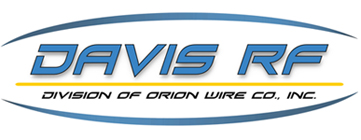Amateur Products
General Information
Most of our amateur products are also sold to commercial clients. Therefore, they must be of high quality, in line with our overall product philosophy. Due to our commercial volume, we are able to afford attractive pricing to our fellow amateur radio operators. We hope that amateurs will refer us to their business associates, continuing a mutually beneficial relationship.

Most hobby customers look for low prices, but usually don't understand the ramifications of price verses quality. Often customers are not in a position to be familiar with the myriad of electrical and chemical variables that are associated with wire, cable, and performance. We have written tech points outlining useful information about wire & cable that one needs in order to make informed choices. So keep visiting us to look for product information and technical tips. When you think of amateur or professional wire, cable, and related items, drop in here!
There are a myriad of manufacturers, each with different quality standards. There are numerous PVC (Polyvinylchloride) and other jacketing compounds produced by chemical companies and purchased by wire/cable manufacturers. These components vary in quality and price. They vary in their resistance to Ultra Violet (UV) resistance and chemical interaction breakdown. Our commercial success requires that we be astute in Polymers.
There is much confusion with the terms "UV resistant" and Non-Contaminating Vinyl ("NCV"). NCV refers to the polymer composition of the outer jacket of a cable. There are plasticizers in PVC and other types of jackets that can contaminate via leaching or migrating through the shield and then into the cable dielectric or into the jackets of adjacent cables. If plasticizers from the outer jacket migrate/leach into the dielectric, this contamination can alter the chemical composition of the dielectric or adjacent jackets, thus affecting the electrical and longevity characteristics of the cable(s).
The way to avoid contamination is to use an NCJ or NCV rated jacket, i.e. non-contaminating. However, not all chemical compounds rated NC are as good as others. With regard to UV protection, i.e. the breakdown of the outer jacket due to UV rays, one needs to obtain quality PVC (likewise if certain other jacket materials are utilized). A good NCJ compound does not necessarily mean good UV protection and vice-versa.
A PVC cable should NOT be buried, even if it is a non-contaminating type. Direct bury cable is achievable using polyethylene (PE) and other jackets. Also, PE does not contain plasticizers therefore it is non-contaminating and also it is highly UV and abrasion resistant (due to its higher durometer and density). For a high grade, low loss, flexible 50 ohm cable, see our BURY-FLEXTM PE jacketed coax. If has a 20 year life and is a strong competitor to LMRTM and HeliaxTM, at significantly less cost (57 cents/ft avg.). Even if you don't need to bury it, it's a wise choice. BURY-FLEXTM was designed by DAVIS RF Co. and is produced by our closely affiliated manufacturer, Advanced Digital Cable, Inc. We are particularly greatful to our associates Steve Payne, General Partner of Advanced Digital Cable and Press Jones, N8UG, The Wireman, Inc. for their contribution to final refinements of BURY-FLEXTM and other superb cables.
We closely scrutinize the chemical compounds available for the applications we are fulfilling. We specify to the manufacturer what we know is most appropriate for the desired, high quality, outcome. Part of the need for this is due to the fact that we design cables and wires for everything from cables reinforced with KevlarTM for monitoring drilling of polar ice caps (where drill bit lubrication slurry can play havoc with insulation), to FDA approved jacket materials inserted inside patients. We work with our manufacturers to effect a highly efficient, quality, long life cable at highly competitive pricing.
Why would you want a highly efficient, quality, long life cable at good pricing verses buying an "equivalent item" at one to a few cents cheaper per foot (a savings of only $3.00 per hundred feet)? Our answer is this: first, cheaper cables usually are not quality "equals" to our cables. Secondly, we have been handling, using, and communicating with cable for years. We also have experience in bouncing signals off the moon, setting ARRL contest records, and working with other RF engineers who design antennas. What we have learned is that RF power out and receiver selectivity, sensitivity, and noise elimination are paramount. These points, however, are immaterial if the cabling is not providing maximum performance. We feel that the entire antenna system is the most important aspect of RF communications (assuming that the rest of the system is operating properly and compared on a watt for watt output basis and conversely on a comparable receive signal level basis).
Cable usually does not "stop working". However, depending on it's construction, it certainly "ages" causing inefficiencies over time. A well constructed PVC cable will last 9-14 years depending on the environment. A good PE will last 18-24 years. Poor cable may last only 30 to 70% of the life of quality cables.
You may not be able to readily realize when cable/signal degradation occurs. Saving a small dollar amount on cable often causes major replacement hassles, $ cost, and unworked DX. Spend the extra small amount; use a highly reputable dealer; take the time to do it right and seal your connectors properly, etc. Then sit back for many years of efficient, no hassle operation.
So the best route must be Belden? The answer is simply no. Belden is your most expensive route. But, like Cadillacs, Whaler Boats, and Lexus autos, you pay extra for the name when you can purchase equal or better quality for materially less cost. Buy Belden if for some reason you need the name and you have extra bucks. We can provide Belden as well. Or buy our equivalents as many of our satisfied commercial clients have!
